Trees Birds Mammals Fish Amphibians Reptiles
Wild Algarve
Bookshop
Mycena megaspora Kauffman - Rooting Bonnet
Phylum: Basidiomycota - Class: Agaricomycetes - Order: Agaricales - Family: Mycenaceae
Distribution - Taxonomic History - Etymology - Identification - Culinary Notes - Reference Sources
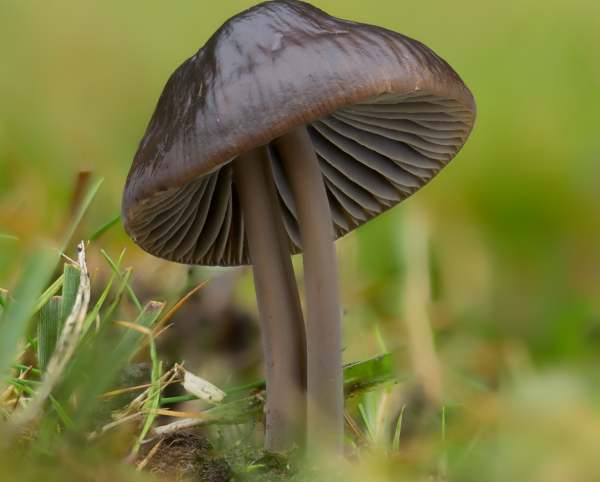
Many of the bonnet fungi are difficult to identify with
confidence, but the dark cap of Mycena megaspora and its heath and peatland preferred habitat are a great help towards confident identification of this rarely recorded bonnet mushroom.
Unlike many of the bonnet mushrooms, Mycena megaspora does not require rotten wood as a substrate; it is at home in mossy peat bogs and on heathland with heather.
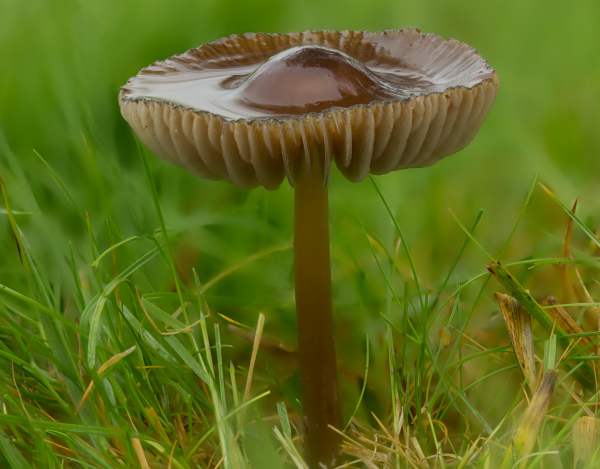
Distribution
This swarthy bonnet mushroom is quite a rare find in Britain and Ireland, perhaps partly because Sphagnum-rich bogs and burnt heathland habitats are not the favoured haunts of many mycologists and other fungus forayers, who tend to focus more on woodlands and low-nutrient grasslands which are easily accessible. The Rooting Bonnet is found in many other parts of mainland Europe, where it is generally reported to be either uncommon or rare. This species has also been recorded in the Pacific Northwest of America where its occurrence seems to be only occasional.
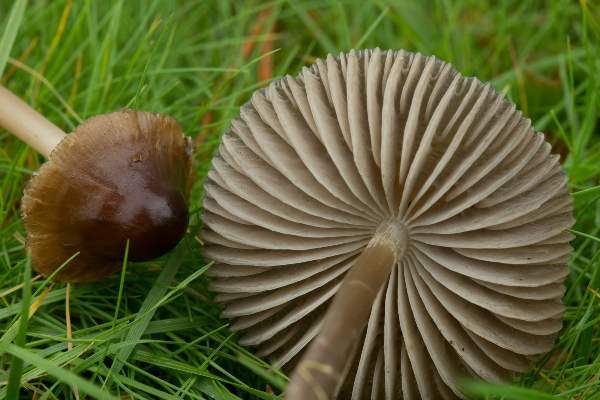
Taxonomic history
When in 1933 American mycologist Calvin H. Kauffman described this rare bonnet mushroom, he called it Mycena megaspora, which is still its generally-accepted scientific name.
In the past Mycena megaspora was sometimes referred to as Mycena dissimulabilis and Mycena permixta; another of its synonyms is Mycena uracea A. Pearson.
Etymology
The specific epithet megaspora comes from the prefix mega- meaning large and -spora referring to the spores. This bonnet mushroom certainly has huge spores compared with those of most other Mycena mushrooms.
As for the common name Rooting Bonnet, this is self explanatory: the stem bases of these bonnet mushrooms often penetrate deeply into their growing substrate.
Identification guide
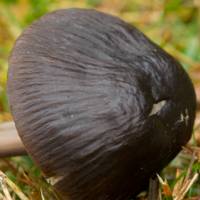 |
Cap
1.5 to 5cm in diameter when fully mature, the
caps are conical to convex, markedly grooved and with a prominent central umbo; the surface is dark grey-brown with a very dark (sometimes almost black) centre; sometimes pruinose when very young. Diverticulate hyphae of the pileipellis are 2-3.5μm wide and are liberally covered with warts and/or relatively short outgrowths.
Stem
3-10cm long and 1-4mm in diameter; hollow; tough, with a long (to 10cm) tapered pseudorhiza (like a root). Stem apex pallid; the lower part darker sepia; surface faintly pruinose when young becoming smooth with age; often twisted with faint longitudinal striations. Cap and stem flesh pallid greyish brown. |
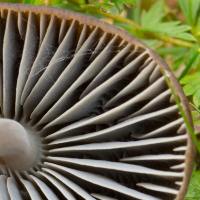 |
Gills
Adnexed or slightly sinuate, the
fairly distant interveined gills are grey and take on a slight pink tinge when fully mature. |
 |
Cheilocystidia
Cheilocystidia (cystidia on the gill edges) are 25-75μm tall and 6-17μm across; they are variously clavate, subcylindrical or irregularly shaped and covered with a variable number of fairly coarse outgrowths (medusa heads). Pleurocystidia (cystidia on the gill faces) are absent.
|
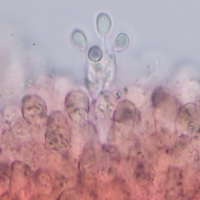 |
Basidia
The clavate basidia are 30-50 x 10-15μm; two-spored and clampless or four-spored basidia with clamps.
Sterigmata
Up to 10 μm long. |
 |
Spores
Very variable in length; broadly ellipsoidal to cylindrical, smooth, 10-16 x 6-7.5µm; amyloid.
Spore print
White. |
Odour/taste |
Slight odour of radish; taste not distinctive. |
Habitat & Ecological role |
Saprobic; on boggy ground, peat and in particular burnt heath, often among Sphagnum mosses rather than, as with many Mycena species, on rotten wood. |
Season |
Mid August to late November in Britain and Ireland. |
Similar species |
There are numerous bell-shaped fungi in the Mycena genus; however, the very dark, largish caps, rooting stem base, and particular growing habitats help to distinguish Mycena megaspora from many of the other darkish bonnet mushrooms. |
Culinary Notes
These little mushrooms are not known to be edible and so I don't know whether they contain dangerous toxins; I therefore recommend that they should not be collected for eating.
Reference Sources
Fascinated by Fungi, 2nd Edition, Pat O'Reilly 2016, reprinted by Coch-y-bonddu Books in 2022.
Penny Cullington, (Oct. 2013). British Mycenas - Brief Descriptions.
Giovanni Robich, (2003). Mycena d'Europa; Associazione Micologica Bresadola ; Vicenza : Fondazione Centro Studi Micologici.
British Mycological Society. English Names for Fungi
Dictionary of the Fungi; Paul M. Kirk, Paul F. Cannon, David W. Minter and J. A. Stalpers; CABI, 2008
Taxonomic history and synonym information on these pages is drawn from many sources but in particular from the British Mycological Society's GB Checklist of Fungi.
Acknowledgements
This page includes pictures kindly contributed by David Kelly.
Top of page...
Fascinated by Fungi. Back by popular demand, Pat O'Reilly's best-selling 450-page hardback book is available now. The latest second edition was republished with a sparkling new cover design in September 2022 by Coch-y-Bonddu Books. Full details and copies are available from the publisher's online bookshop...